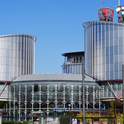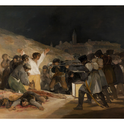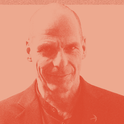According to the historian Roy Foster, after centuries of misfortune, the Irish have finally got lucky. On most weekends you can see some of the luckiest at play at Ireland's big racetracks—rough-handed farmer types, wads of notes at the ready, who arrive by helicopter with their well-dressed ladies and are as comfortable in the owners' enclosure as in the company of the other punters pressed against the rails. On my last visit to the races, I saw one such man emerging from a corporate marquee, flute of champagne in one hand, pint of the black stuff in the other. It was a fitting image for Ireland's new rich.
For the first time in Irish history, some of these racegoers have become, almost overnight, part of a big, indigenous moneyed class. In a population of just 4m, there are, according to Bank of Ireland, more than 30,000 euro millionaires—up from a few hundred 20 years ago—and at least 300 people worth over €30m. Almost all are self-made, and much of the money has been made in only a decade or so.
This new class is a creation of the country's extended economic boom and an associated leap in property values. The country entered the 1990s with an unusually benign combination of a growing, well-educated workforce and strong demand for labour, the latter the result of high levels of inward investment, much of it from the US, attracted by low taxes and light regulation. At one point it was said that every fifth job created in the EU was in Ireland. Average annual growth of 7.2 per cent over the past ten years has encouraged Irish expatriates to return home, and more recently Poles and other immigrants have maintained the growth rate of the labour force. All this has helped to give Ireland the second highest per capita income in Europe (behind Norway), well ahead of Britain and the US. But if there is broad consensus about the causes of Irish economic take-off, there is less agreement about the people in its vanguard—Ireland's new rich. Are they leaving a permanent mark on business life, or are too many of them just speculators? How philanthropic are they? What are they doing to Irish society, and to Ireland's view of itself?
The Irish did make money in earlier generations, but they usually had to leave Ireland to do so. US boardrooms are full of Irish names. In England, too, several top companies are run by first or second-generation Irish, such as Terry Leahy of Tesco or Niall FitzGerald, former Unilever boss. But the booming economy has reversed the flow of migrants and allowed this generation of Irishmen and women to exploit their entrepreneurial talents at home.
There is some old money in Ireland, including the heirs to the Barry's tea-importing fortune and the other so-called merchant prince businesses in Cork. The Guinness family is still very rich, but its scions are no longer involved in the brewing or banking businesses. There are also some landed Anglo-Irish families, descendants of British settlers ceded land by the crown. The term "Anglo-Irish" still denotes privilege and class, although given the decline of this elite, Brendan Behan's description of an Anglo-Irish as simply "a Protestant on a horse" seems more apt.
In the 1980s, a new wave of businessmen multimillionaires emerged. One of the best known is Michael Smurfit, who turned a Dublin cardboard box company into a global paper and packaging concern. His rival Tony O'Reilly rose to be chairman of HJ Heinz, the first non-family member to lead the US food giant. He reinvested the money he made there in a number of Irish companies, including Independent News & Media, a newspaper group, and Waterford Wedgwood, a tableware manufacturer.

Smurfit and O'Reilly took 30 years or more to get to their current positions. Many of the big names in the next wave also took time to get established. But the most recent crop of multimillionaires—most of whom remain little known in Ireland, let alone outside—have made their fortunes in ten years or less, many of them in property or building.
Ireland's expertise in construction is well established; in Britain there are big contractors—such as J Murphy & Sons and Laing O'Rourke—that trace their roots to Ireland. But the origins of the new Irish property fortunes are home-grown—indeed, as so often with property, they are found at the confluence of politics and business. In fact, some people trace the boom back to a single crucial meeting in 1982, at which Charles Haughey, the populist Fianna Fáil leader, was seeking the support of Tony Gregory, a feisty independent member of the Irish Dáil, to help form a minority government. The pair struck a deal, involving pledges on Haughey's part to sink large amounts of money into inner-city regeneration in Gregory's Dublin constituency. The tax breaks to persuade the private sector to invest proved successful, so the government extended them to tourist and leisure facilities, kickstarting a whole industry.
When the economy took off in the early 1990s, those in the property and construction sectors were well placed. Increased employment and rising incomes, coupled with very low borrowing costs as Ireland prepared to join the euro, fuelled demand for housing and commercial property, pushing prices even higher. In the countryside, planning controls were minimal, encouraging a wave of small building projects, while farmers with land near big towns became instant millionaires, and family retail chains saw a sharp rise in their value with the arrival of the British multiples. But the biggest winners were the builders and developers with the foresight to acquire large land banks before prices took off in 1994.
The successful property magnates are not easily typecast. Many are from rural Ireland, not Dublin or the other cities. Some are graduates; a few were privately educated. But several started out as farmers or even labourers. Many of them now travel by helicopter, but they often still like to put on a hard hat and walk their sites. It is said they are more likely to build on golf courses than play on them. You will see them at race meetings or Gaelic sports events rather than rugby or football. And they probably have fewer "airs" than an earlier generation of businessmen. It is hard to imagine Johnny Ronan of Treasury Holdings or Seán Mulryan of Ballymore Properties accepting a knighthood from a British monarch, as Tony O'Reilly and Michael Smurfit did.
Johnny Ronan, with his jet-black beard and long hair, is the industry's most dashing "high roller." The son of a wealthy Tipperary pig farmer, Ronan was privately educated, and after school trained as an accountant. There is a fund of stories about his exploits. After winning one bitter planning battle, he celebrated by flying 50 friends to Italy, where Luciano Pavarotti sang for them in the garden of his villa. A few years ago, he sent a voucher to his business rivals informing them that they had each had a Guatemalan pig named in their honour, as part of a fundraising effort by Trocaire, a Catholic charity. He is a keen huntsman and art collector, and owns a Humvee amphibious US army jeep as well as a €650,000 Maybach, described as "a Mercedes on steroids."
Seán Mulryan likes to spend too. Debbie Harry performed at his 50th birthday party. He owns two executive helicopters, and racehorses and studs in both Ireland and France. Yet if Ronan is something of a playboy, Mulryan is a solid family man. He is known to bring his elderly mother to the opening of some of his biggest projects. He also has the more romantic rags to riches story. He left school early to become a bricklayer and stonemason. He then got started in business by remortgaging the family home. Today he is probably Ireland's most successful international developer; his company Ballymore has assets of around €22bn, and claims to be the largest landowner in London's Canary Wharf. It also has big property interests in eastern and central Europe, another favourite market for Ireland's new rich.
The tycoons tend to be politically well connected. Come August, many will be found hobnobbing in the Fianna Fáil tent at the Galway races. But it is difficult to say how important political connections have been to the rise of the property tycoons. The cronyism and corruption that were a feature of Ireland under Charles Haughey have not totally disappeared. But if Haughey was linked with the early careers of several businessmen, such as Dermot Desmond, the evidence from various tribunals suggests that the tycoons did more for him by financing his expensive lifestyle than he ever did for them.
Yet big property developments still inevitably require some political input. The rezoning of land from agricultural to commercial use, or from low rise to high rise, has been at the centre of accusations that the Dublin authorities tolerated the "brown envelope" culture of crony politics that so damaged Ireland's image in the 1980s and early 1990s.
A tribunal looking into corruption in Dublin planning discovered Seán Mulryan paid 50,000 Irish pounds between 1994 and 1998 to Liam Lawlor, a Fianna Fáil deputy and Dublin councillor, although it found no evidence that this had influenced any decisions. Mulryan was at the time trying to secure planning permission for the Baldoyle racecourse site near Dublin airport, which he bought for €30m in 1996. In 2004, he sold half the site, with rezoning, for €95m. In the late 1980s, the same site would have fetched less than €1m. "Land has always been rezoned… and it will always be controversial," Mulryan insists. Corruption has not gone away, especially in the provinces, but Dublin at least appears to be cleaner.
Most of the new property tycoons live in Ireland—often doors apart in the same few streets in Dublin 4, from where they fight each other's planning applications. Equally important for their public image, they are tax residents in Ireland, whereas Smurfit, O'Reilly, Magnier, Desmond, McManus and O'Brien are all tax exiles. However, the difference is less than it seems. The tax reliefs for the stay-at-homes have been very generous. So much so that finance minister Brian Cowen announced in 2005 that he was scrapping many of the reliefs, pledging to "eliminate the phenomenon of tax-free millionaires."
Some critics compare Ireland's property tycoons with the Russian oligarchs. According to one estimate, six or seven businessmen own almost all the commercial property in Dublin. Such a concentration of ownership was probably last seen in the days before Irish independence. In those days Irish land was worth a fraction of that in England, but it now commands a large premium, despite Ireland's much lower population density. During the boom years, farmers were very well compensated as the government pressed ahead with EU-funded road and infrastructure programmes. And in areas close to Dublin and other cities, land prices were inflated as councils competed to attract jobs and businesses.
This home base of valuable property has launched a new generation of Irish property investors on to the international market, particularly into the old imperial capital, London. Today, few big property deals in London get done without some Irish presence. It is said that half of Bond Street is now Irish.
There has clearly been a political aspect to this—although it has not been much noticed in Britain. In 2004, Derek Quinlan, a former Irish tax inspector, paid £750m for the Savoy Group of hotels in London. Like other big foreign deals, this was reported in the Irish media as a matter of national pride. Indeed, Quinlan recalls that an Irish employee at the Connaught Hotel, part of the Savoy Group, ran the Irish tricolour up the hotel's flagpole when the story broke. "It was put up without my knowledge," he said. "But I cried. My poor father, who was in the Irish army, would have loved to have seen this."
Unsurprisingly, the emergence of Ireland's new rich is not universally welcomed. Although modern Ireland has never had a strong labour movement or a clear left-right axis to its politics, there is an egalitarian and classless streak in the national self-image that is not completely comfortable with a large moneyed class.
David McWilliams, the Irish economic commentator, is not alone in complaining about the rise in inequality: "The return to land today, and the fundamental inequality to which it has led, is more dramatic now than at the height of the Land League's campaigns in the late 19th century," he claims.
But so long as the majority of Irish voters continue to benefit from the country's success, there will be little concerted hostility to the tycoons. The Irish seem to have an emotional attachment to property, and more viscerally to land, an attitude some say is a direct legacy of British colonialism.
"We'd been poor for so long that any form of development… was welcomed. There is no mood in public opinion to be very critical," says Garret FitzGerald, prime minister in the 1980s for the conservative Fine Gael party. And ordinary people are benefiting, at least from the property boom: the proportion of national wealth tied up in residential property is 74 per cent against the European average of 57 per cent. This is reflected in the rate of Irish homeownership at 77 per cent, compared with 71 per cent in the UK, 56 per cent in France and just 43 per cent in Germany. Housing demand is also running at much faster pace, with 88,000 new homes built in 2006, compared with 155,000 in England and Wales, an area with 13 times as many people. In 2004, The Economist ranked Ireland's quality of life as the best in the world, saying that Ireland "combines the most desirable elements of the new, such as low unemployment and political liberties, with the preservation of certain cosy elements of the old, such as stable family and community life."
The more left-wing parties, like Labour and Sinn Féin, complain about the increase in income inequality and the fact that social infrastructure has not kept pace with private affluence, but neither party has performed well in recent years. And although inequality has grown and there are still plenty of poor people visible on the streets of the big cities, protest has been muted. One reason for this is that Ireland's economic and social model has always been closer to the laissez-faire US than to continental Europe ("more Boston than Berlin"). For example, Ireland has no universal health service: nearly half of the population has private medical insurance, and less than 30 per cent are covered by the state-funded "medical card," which entitles holders to free care. Nevertheless, Christopher Whelan of the Economic and Social Research Institute in Dublin says: "There are people who feel the country has gone to hell, and there are those with a relative loss of position. But there are also increased opportunities… and the underlying rules of the game have not changed fundamentally."
One group that is often disdainful of the new rich is Ireland's old elite of mainly Dublin-based senior civil servants, lawyers, journalists and artists. According to David McWilliams, this group is showing a renewed interest in the Irish language, and sending its children to the Dublin Gael schools, where the teaching is in Irish, as a means of distinguishing themselves from the brash newcomers.
Some of this has less to do with the new rich themselves so much as a broader feeling that the sudden influx of money has caused old, homely Ireland to lose its soul. In November, Brenda Fricker, the Oscar-winning Irish actress, voiced a general misgiving about the changes that the Celtic tiger has wrought when she told a local radio station that she was selling her house in Dublin to escape what she called "the money-motivated thing." The city had "become very tough and hard," she said.
When Christian Pauls, German ambassador to Ireland, had expressed similar sentiments two months earlier, he was slapped down by a foreign ministry spokesman and forced to apologise. But it was clear from the deluge of supporting letters to the Irish Times that he had struck a chord with many in the Irish professional class.
There is, of course, some excess. The rich Irish think nothing of flying to the US for a weekend of shopping, and party invitations among the elite now routinely include longitude and latitude details for the benefit of incoming helicopters. But many of the new rich are from humble origins, and aware of the offence that flaunting their wealth can cause. "You won't see any boats in Irish marinas over 60 foot. Not that they don't own them, but they keep them elsewhere," reports one financial adviser.
What about the accusation that the new rich are not putting money back into society or culture, in the manner of rich philanthropic Americans? "There is a gangster charm about some of the property people," says Michael D Higgins, foreign affairs spokesman for the Labour party and a former arts minister. "But what I regret is they haven't the imagination to fund an orchestra, or a piece of public sculpture."
But others in the arts and education worlds say the new rich are generous donors. In 2005, Martin Naughton, founder of Glen Dimplex, an electrical appliances company, donated €5m towards a new nanoscience research institute at Trinity College, and last year his company began sponsoring a new set of literary awards. Mick Wallace, Wexford-born founder of Wallace Construction, has funded the rebuild of Dublin's New Theatre. Michael Colgan, director of Dublin's Gate Theatre, says it is a matter of how you approach the new rich: "They are not the sort of people who want to sit on cultural committees and feel patronised. With these guys you take them out to lunch and they will sign a cheque for €50,000. It's not because they love theatre, but they see the Gate as part of an Ireland they want to feel proud of."
They are using their money to make a statement—and the statement is that Ireland has arrived. Consider the sponsorship of Goffs Million, a race invented by the Irish bloodstock auctioneers in the 1980s. The original idea was to get buyers into the company's sales ring, because only those yearlings bought at the previous year's sales could compete in the race. It became one of the richest events in European racing. The first sponsor was Cartier, the French jeweller. Today the race carries the name of a hotel, the Parknasilla, owned by Bernard McNamara, a county Clare property developer.
Twenty years ago, you could count the seriously rich Irish on the fingers of one hand. Today there are so many very rich people that even the professional wealth managers can't keep track.
The country has had an incredible run. It is still looking at a growth rate for 2008 of 3 per cent. But for Ireland that is a slowdown, so much so that the December budget cut taxes on house purchases to stimulate the market, amid concerns that an economy so buoyed by a historic shift in the price of property may be heading for a hard landing. As the boom winds down, the question is: have the new rich created something permanent?
Some commentators complain that compared to business builders like Smurfit and O'Reilly, the new moneyed class are just property speculators. One measure of this is the dearth of new listings on the Irish stock exchange. And the Irish boom has certainly been heavily concentrated in the property sector. About a third of the 80,000 individuals setting up businesses between January 2003 and June 2006 were in construction. On the other hand, for many, especially in rural Ireland, property was simply the opportunity to hand, and they applied to it the sophisticated business skills required of a modern farmer.
What of the money itself: will the new rich fritter it away? Richard Nesbitt, great-great-grandson of the founder of Arnotts, the department store company, is confident that most of the new money will survive, as has his family's. "I think we have come of age. A lot of families are keeping their heads down and husbanding their wealth, quietly consolidating it." David Drumm, CEO of Anglo Irish Bank, agrees. "It's not about the mad Irish squandering the wealth. They've been squirrelling it here and overseas. We've established a base of wealth that was never in Ireland before."
One consequence of all this is that the Irish are now looking at themselves differently. The image of humble but poetic Catholics living in the shadow of the stiff and snobbish Protestant English is no longer meaningful on either side, even as caricature. The nation of "saints and scholars" has shown over the past decade that it has a genius for business too.
Garret FitzGerald believes that the rapidity and scale of the economic change has no parallel elsewhere in Europe. Among some citizens there is, inevitably, a feeling of disorientation at the social changes—including the arrival of mass immigration (10 per cent of the population is now foreign-born). Moreover, the one institution that has consistently distanced itself from Ireland's embrace of hypercapitalism—the Catholic church—is weaker and more marginalised than ever before, thanks in part to the scandals of clerical child abuse.
The disorientation of the post-Celtic tiger world was summed up for many by the construction of a vast steel spire on O'Connell Street in Dublin to mark the millennium. For some, the monument was just a flagpole with no flag. But to others, the landmark—built on the site of the old Nelson's Column, blown up by the IRA in 1966—is a defiant statement about the new Ireland, its new wealth finally allowing it to escape from the shadow of its neighbour.
In the 19th century, and much of the 20th, the Irish went to Britain to build canals, roads and other infrastructure. Today Irish developers acquire trophy assets in the City of London and other parts of the capital. One of the consequences of this change in relative status, FitzGerald points out, is that reunification of the island could be more difficult to achieve—a project still close to the heart of nationalist Ireland. "The north is so much poorer. They couldn't afford to join us and we can't afford to subsidise them," he says.
On the other hand, relations between Ireland and Britain, and particularly between the Irish and the English, have probably never been better. As the Irish increasingly look beyond Britain, they have become less chippy about their relationship with their giant but often insensitive neighbour. "The Irish inferiority complex has disappeared and the British superiority complex has been weakened," says FitzGerald. Of course, he adds, relations will never be truly equal and Britain continues to cast a big cultural shadow over Ireland—British television, for example, is ubiquitous. "You can't have equality between 4m and 60m. But there's certainly less inequality."
Roy Foster titled his classic essay on Anglo-Irish cultural relations in the Victorian period: "Marginal Men and Micks on the Make," describing the Irish who did well in Britain at that time. But in his latest book on modern Ireland, Luck & the Irish, he describes how the new wealth has transformed Ireland's image of itself. "Ireland is like the French third republic," he said recently. "You have this buccaneering corruption. You have an instability of politics. You have loads of money washing around and you have a great moment of cultural fluorescence… It is an interesting combination, and in ways, given Ireland's past history, rather a liberating one."
Click here to discuss this article at First Drafts, Prospect's blog











